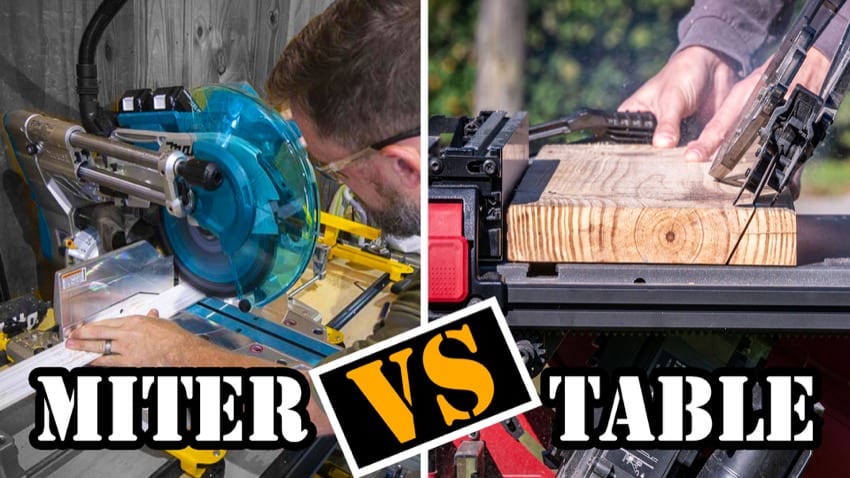Make no mistake—miter saws and table saws are powerful tools for getting serious work done in the shop or on the jobsite. Most Pros know how to use a miter saw vs table saw, but DIYers or those just starting out may not quite understand when exactly you want to use each of these power tools. We not only want to show you the differences between miter saws and table saws but also help you understand where each tool excels. That involves going over the strengths and weaknesses of each as well as talking about potential uses and costs.
Editor’s Note: Check out our best miter saw article for our top recommendations.
The Purpose of a Miter Saw vs a Table Saw
At its heart, a miter saw cuts angles across narrow pieces of wood. That might be 2X lumber, but more often than not, you cut crown, base, chair rail, or cove molding with these saws. You may also find yourself cutting flooring. If you don’t need to cut angles, a miter saw makes quick work of cross-cuts when you need to shorten a board or piece of trim to length.
A miter saw cannot make longer cuts simply because you’re limited by a combination of the style of saw (sliding or non-sliding) and the blade diameter. As you can imagine, a 12-inch sliding saw has much more cross-cutting capacity than a 7-1/4″ non-sliding miter saw. Regardless of blade size, however, neither miter saw is equipped to rip a piece of 3/4-inch plywood!
Contrast that to a table saw, which excels at ripping wood or changing the width of a piece of wood. It typically cuts with the grain or otherwise alters the width of a board. It’s designed to make cuts that are nearly infinite in length.
Let’s break it down into something even more simple:
Use a Miter Saw for
- Cross-cutting boards
- Cutting all types of molding
- Beveled end cuts
- Repetitively cutting boards to length
- Flooring, trim, siding
Use a Table Saw for
- Ripping narrow boards or lumber
- Cutting longer, larger pieces of wood like plywood
- Cabinet work
- Sheet goods
Table Saw vs Miter Saw Safety
With a miter saw, you cut using the bottom of the spinning blade. A miter saw’s blade rotates so that the exposed part of the blade moves away from you. That also means that any wood caught up by the blade gets thrown away from you.
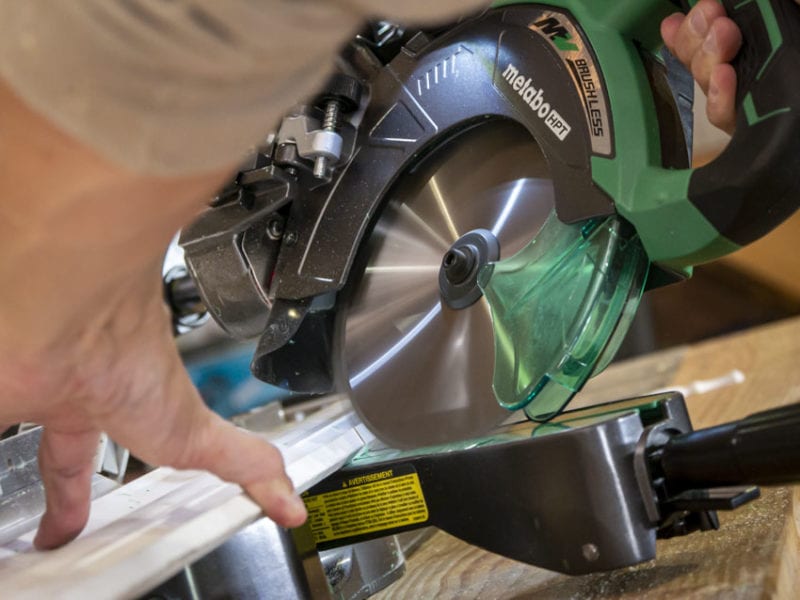
With a table saw, you cut using the top part of the blade. Because of this, the blade actually spins toward you. If a piece of wood gets caught on the blade (known as table saw kickback) it generally moves back toward you—very quickly.
Both tools have safety measures and guards to protect against these problems. Miter saws have a guard that covers the blade as it lowers to engage the wood. That keeps you away from the part of the blade that faces you as you cut. These saws also typically warn you against putting your hands too close to the blade when holding material against the table or fence.
Use the Supplied Accessories!
All table saws also ship with push sticks. Use these instead of your hands to push wood past the blade. All manner of methods for creating jigs, feather boards, and other safety devices exist online to help you safely use a table saw.
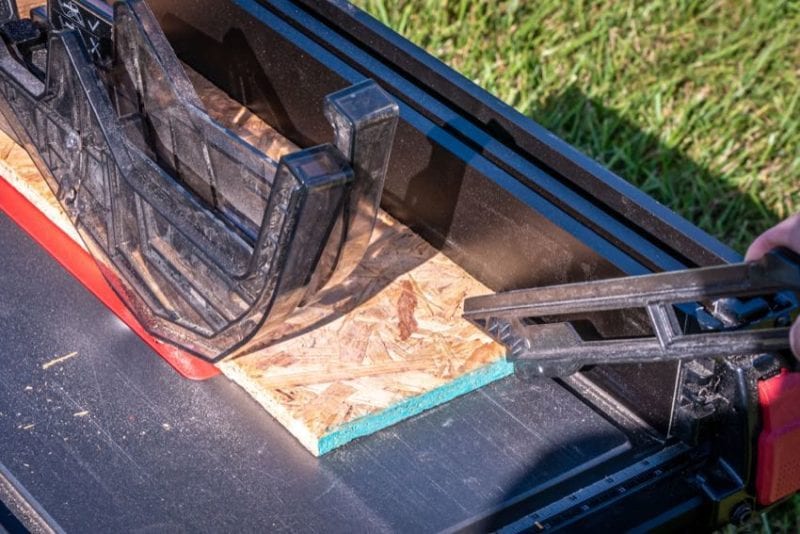
Table saws have blade guards that do an excellent job covering the blade, however other dangers exist. For that reason, they also have a riving knife. This keeps the backside of the wood from coming together and pinching. Wood that “re-encounters” a table saw blade once it passes, can be thrust—suddenly and unexpectedly—back over the top of the blade at the operator. “Anti-kickback pawls” also come standard on modern table saws. These help prevent the wood from coming back towards the blade once it passes.
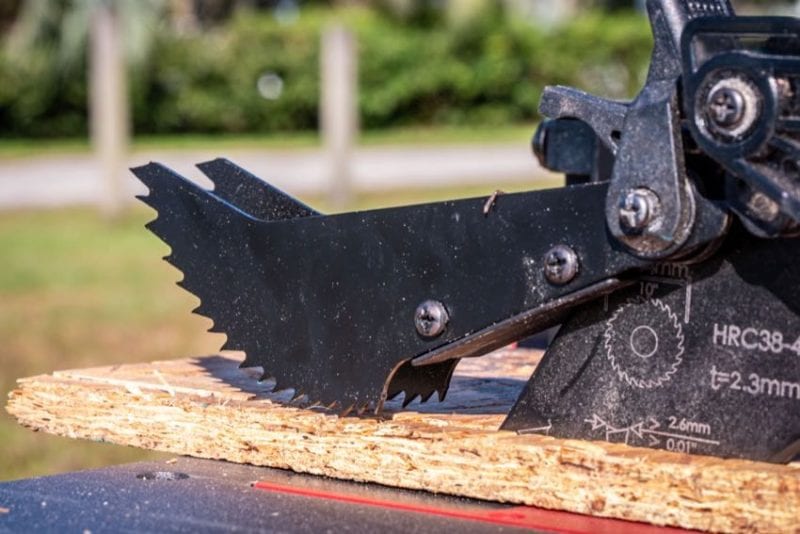
One last technology which exists for tables saws comes in the form of flesh-detection technology like that found in the SawStop jobsite table saw. This detects, very quickly, when a body part touches the spinning blade. When this occurs, a violent reaction sends an aluminum “brake” into the saw blade, stopping it instantly and driving it down below the table.
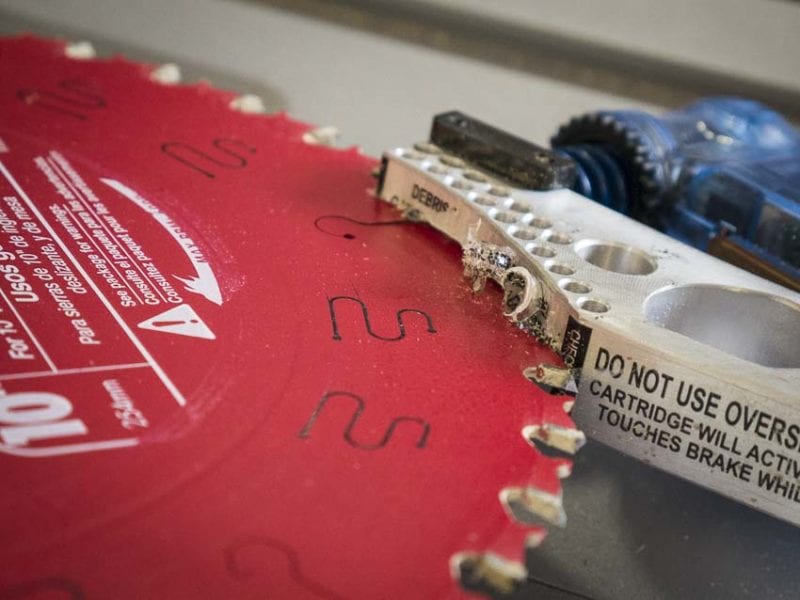
Lastly, with respect to features, a miter saw fence sits at the back of the tool perpendicular to the blade. You place your wood against it in order to make a beveled, mitered, or compound crosscut. With a table saw, the fence sits parallel to the blade. Using a table saw fence, you measure between it and the blade to set the width of your cut.
When to Use a Table Saw vs Miter Saw
As mentioned above, a miter saw typically gets a lot of use when cutting boards to length. We’ve used them when installing hardwood flooring and laminate flooring. A miter saw even came in handy when doing a large siding job on a historic home.
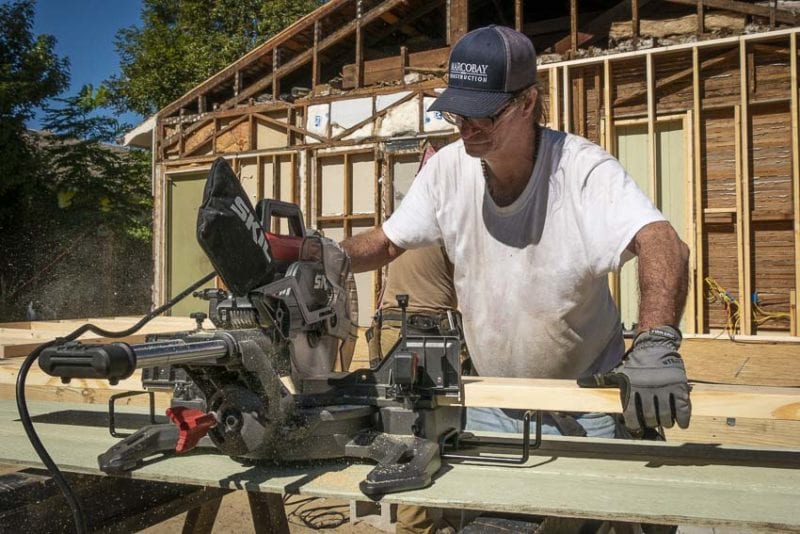
Often mistakenly called a “chop saw”, a miter saw often shows up on a framing job site to cut lumber to exact lengths when framing out windows and doors.
Table saws don’t often hit the jobsite except when really needed. When framing, many of the cuts typically made by a table saw can be made by a circular saw or track saw. That saves a lot of hassle over setting up a table saw to rip wood that doesn’t need 1/32″ precision.
That leaves the carpenter’s workshop and cabinet shop. Here, a table saw truly comes alive. It can quickly and powerfully make consistent, repeatable cuts for making furniture, crafts, and cabinetry. Table saws provide exceptional precision and speed when making cuts at repeated widths. They also remove a lot of hassle when needing the make cuts to thinner materials which a circular saw simply won’t allow.
Miter Saw Stand vs Table Saw Stands
The best miter saw stand will include outfeed supports and/or rollers. These let you quickly and easily make cuts to length. We prefer a gravity-rise miter saw stand, but these do weigh a lot more than compact solutions. Because of this, you want to factor in whether you plan on wheeling your miter saw stand in and out of a trailer or if you need to lift it into a truck bed.
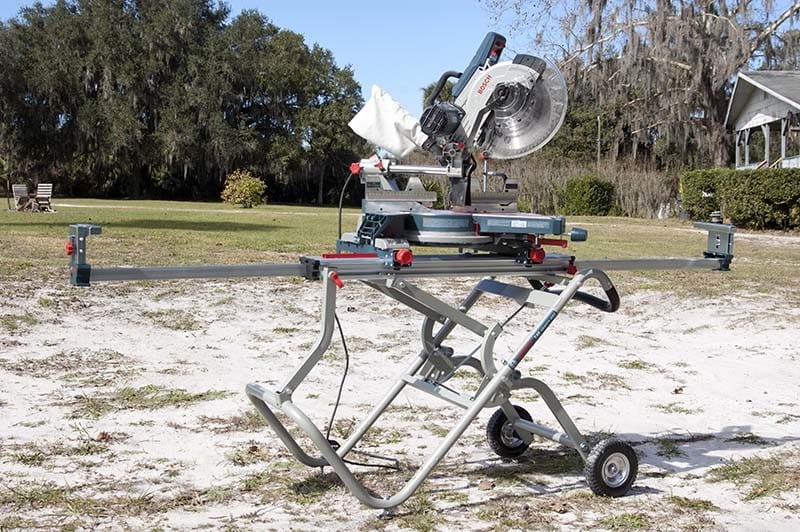
Table saw stands can also make use of a gravity rise stand. Keep in mind, however, most table saws already weigh quite a lot. You may opt for a compact model if you intend to bring it to a jobsite for work that requires it.
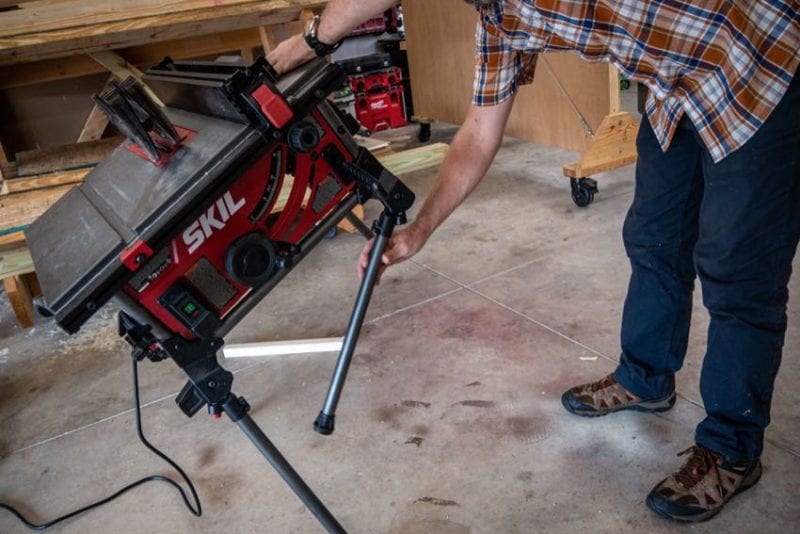
For shop use, a rigid stand works best. You can even find cast-iron models with cabinet saws that include heavy-duty casters. These let you wheel even some of the heaviest-duty table saws around a shop to afford you more space.
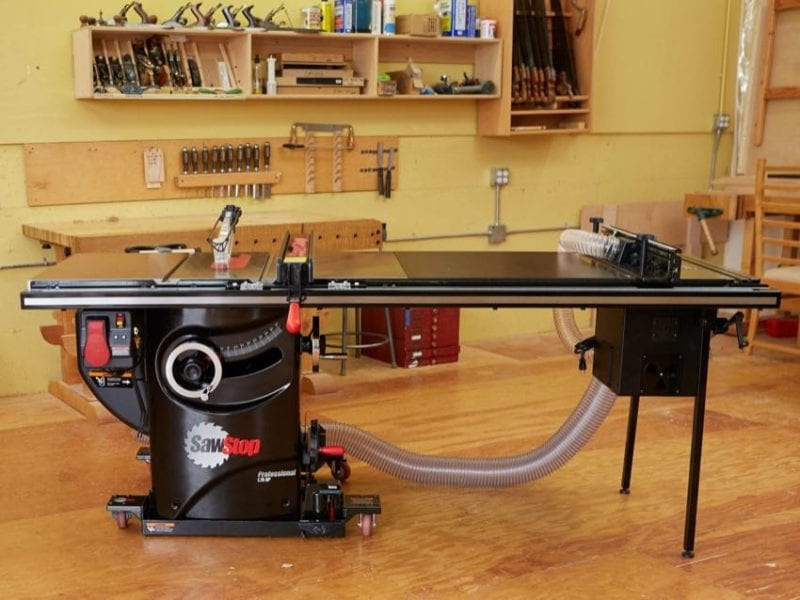
Miter Saw Blades vs Table Saw Blades
When comparing a miter saw blade to a table saw blade, several things come to mind. For starters, most jobsite table saws come with either 8.25-inch or 10-inch blades. That lets them rip through sheet goods and flooring. Of course, other 1/2-inch or 3/4-material presents little difficulty as well.
New rules have forced table saw manufacturers to increase the table size with the blade. That means that, now, compact saws more than likely ship with a smaller 8.25-inch blade.
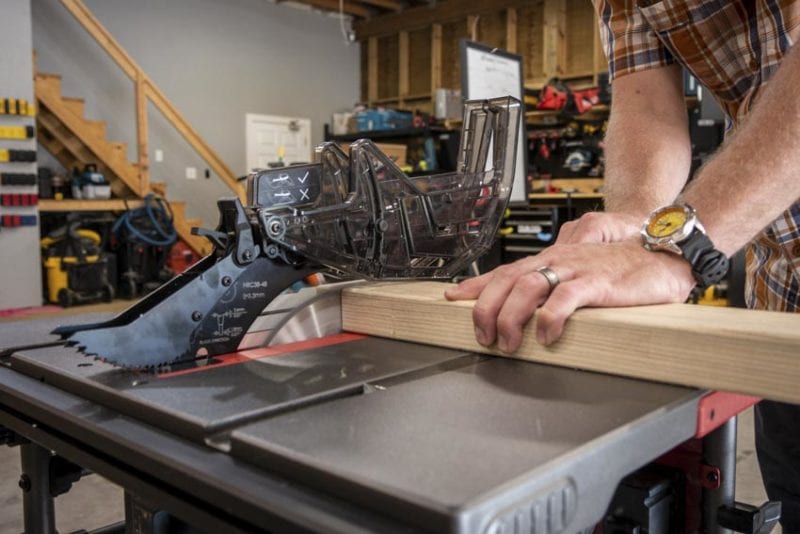
Table saws get much larger as well. In face, large saws designed for furniture production and cabinet-making can have blades of up to 16-inches or larger.
Moving on to miter saws, blades typically fall into one of a few categories. Compact 7.25-inch blades for ultra-portable jobsite saws. We love these as they provide a way to do small trim jobs without having to lug around a larger saw. You can also use the same blades you put on your circular saw, so finding one comes easily.
A 10-inch blade presents the sweet spot for miter saws. That goes triple if you grab a dual-bevel sliding compound miter saw. The best miter saw with a 10-inch blade can cut nearly to the capacity of a larger 12-inch miter saw. The only real difference comes when making specialty cuts on the rear fence with larger crown molding and base.
Wrapping it Up
If you came here because you wanted to buy a single tool and weren’t sure which one…we do have an answer for you. A table saw provides more versatility overall. Because it ships with both a rip fence and a miter gauge, you can make both rip cuts and crosscuts.
If, however, you have a ton of crosscuts to make—as you might find in a flooring project—we recommend both. The miter saw makes easy work of your starter and ending crosscuts. With a table saw, you can rip those long planks needed for those final against-the-wall pieces.
We hope this article was helpful. If we missed anything, please feel free to leave a comment below.

